Salesforce, for over a decade, has led the Customer Relationship Management (CRM) sector, boasting a market share of 23.0%, according to a report from Salesforce itself. Renowned global organizations such as Spotify, Toyota, Canon, and other 150,000 companies trust Salesforce for sales and marketing operations optimization.
The reason for this overwhelming preference towards the Salesforce solution lies in its successful implementation outcomes. A well-executed Salesforce implementation can result in an average revenue increase of 37% and a productivity boost of 44%.
If your company is poised to implement Salesforce CRM and you’re keen to grasp its intricacies, our detailed guide is an invaluable resource.
This article outlines:
- What Salesforce implementation is and how long it takes,
- How to prepare for the Salesforce implementation process,
- Common Salesforce CRM implementation strategies comparison,
- SF implementation best practices.
- Why it is important to involve a Salesforce implementation consultant at the early stage.
What is Salesforce Implementation?
Salesforce implementation is a process of rolling out its core product — CRM (customer relationship management) system — to centralize all key business activities and communication. This platform unifies the 3 most common CRM product types, namely operational, analytical, and collaborative, making it the #1 CRM solution on the market for the 11th year.
“ Successful Salesforce implementation, first off, must have a balanced approach that focuses on the technology design, the people that are going to use it, and the processes that are to be supported by the salesforce system. ”
Wes Snow, the CEO & Founder at Ascendix Technologies
Why Implement Salesforce Right Now? Key Benefits
Salesforce’s comprehensive infrastructure comprises an extensive array of native products including Sales Cloud, Service Cloud, Marketing Cloud, and Experience Cloud. Each of these products is meticulously designed to meet the specific needs of sales, service, and marketing professionals.
Here are the results of Salesforce customers they’ve managed to achieve thanks to the implementation of various Salesforce products.
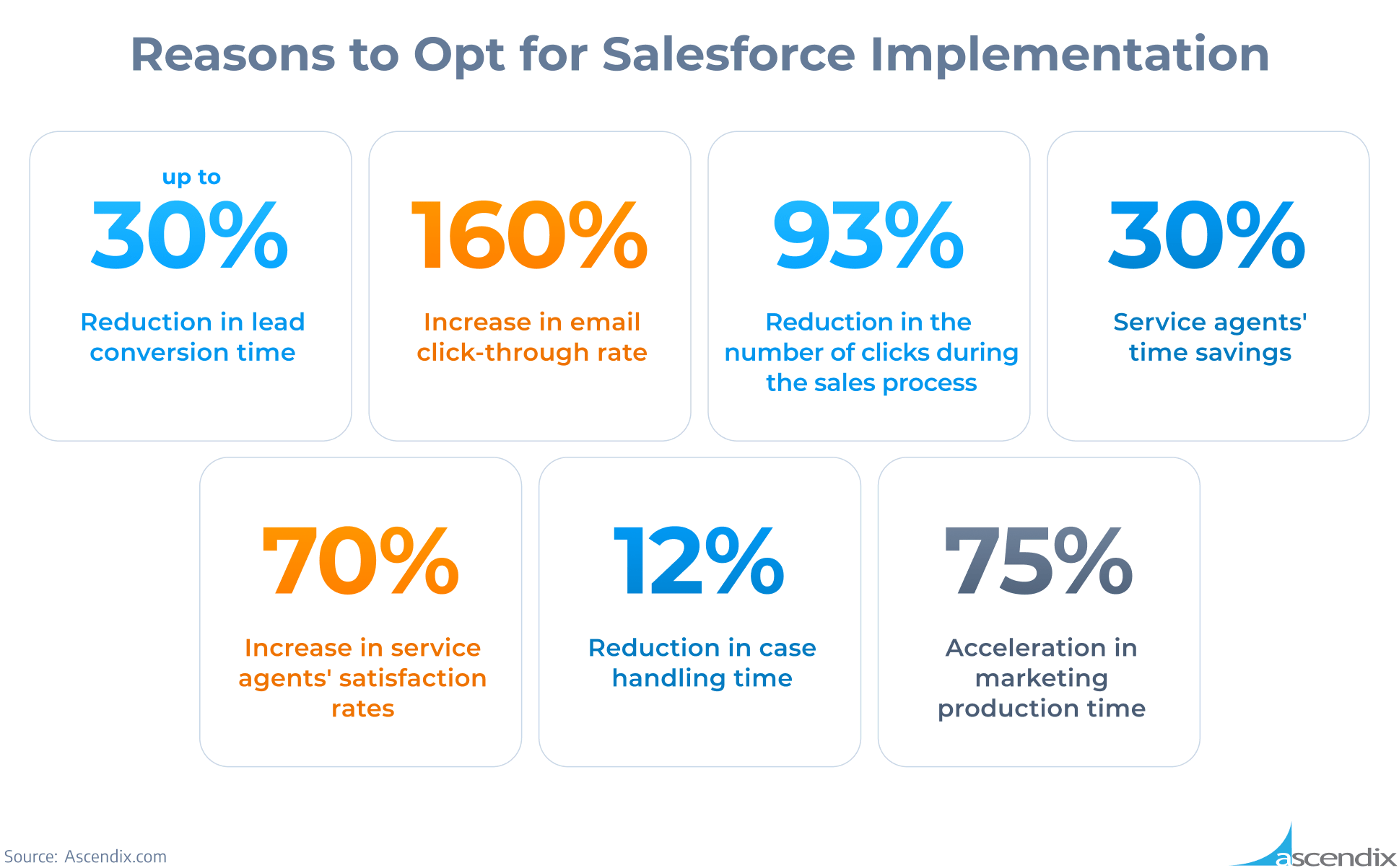
Reasons to Opt for Salesforce Implementation | Ascendix
By implementing Salesforce Sales Cloud, companies can:
- Improve their lead conversion process, reducing time-to-close by up to 30%,
- Achieve a significant 160% year-on-year increase in email click-through rates,
- Reduce the number of clicks during the sales process by 93%.
Similarly, the deployment of Salesforce Service Cloud can:
- Lead to a 12% reduction in case handling time,
- Save service agents’ time by 30%,
- Increase their satisfaction rates by an impressive 70%.
Utilizing Salesforce Marketing Cloud can:
- Accelerate marketing production time by 75%,
- Boost conversion rates by 16%,
- Expedite lead segmentation by 30 times.
The Salesforce Platform, renowned for its “click-not-code” approach, can save an average of 80 developer hours and accelerate project delivery by four times.
In addition, Salesforce houses 4,000+ third-party tools within its AppExchange, augmenting the platform’s operational capacity.
Moreover, thanks to Salesforce’s popularity, there is no scarcity of SF experts equipped to aid in the implementation and customization of your Salesforce solution and you can seamlessly delegate these tasks to a proficient Salesforce implementation partner possessing in-depth platform knowledge.
Need Help with Salesforce Implementation?
Our consultants will teach you how to use CRM software to the fullest without overpaying for unnecessary functionality.
Salesforce Implementation Process Checklist: How to Prepare in 10 Steps
Salesforce is a serious investment, so the preparation process shouldn’t be taken lightly. Before initiating your project, learn about the steps outlined in this Salesforce implementation guide.
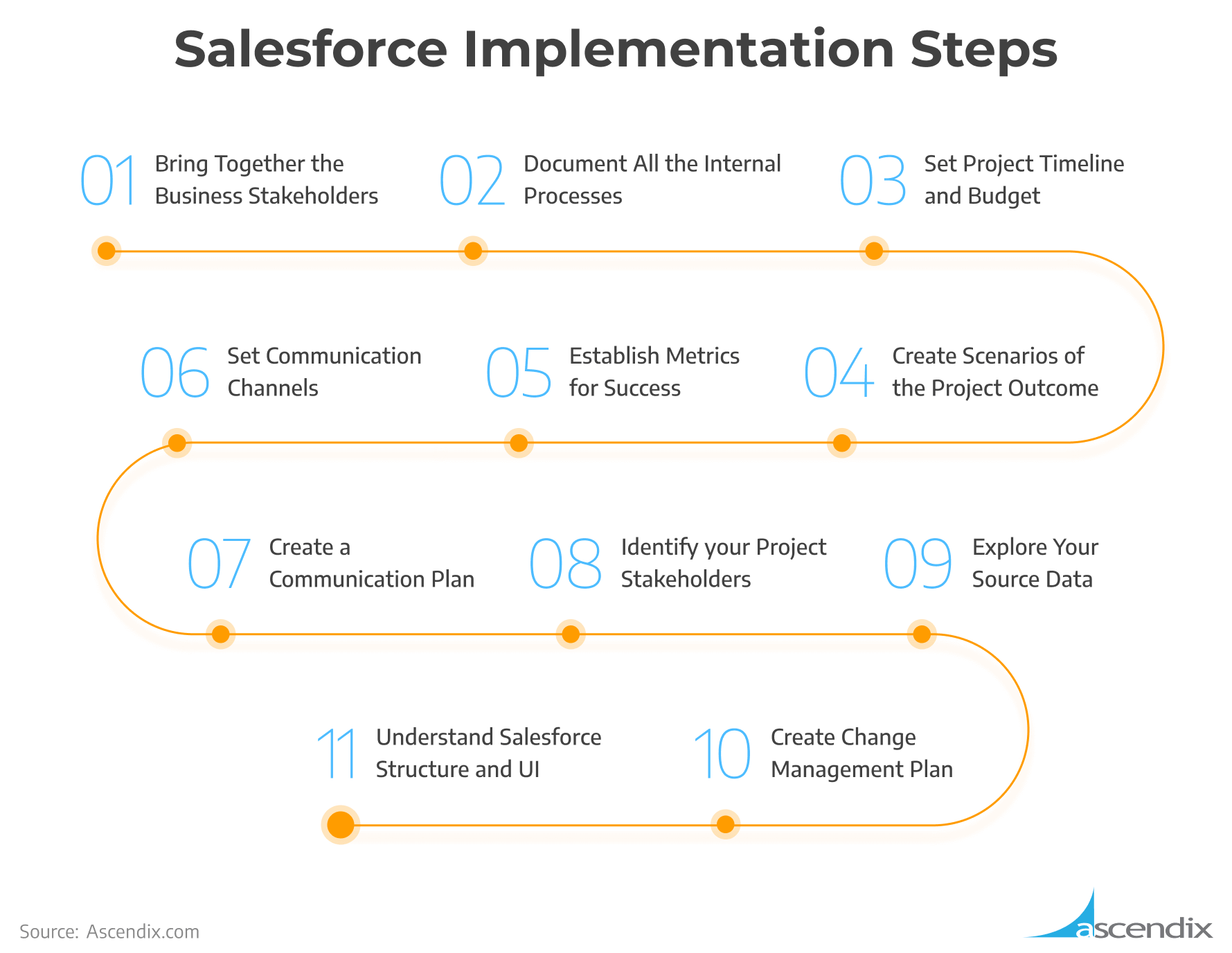
Salesforce Implementation Steps
Step #1: Identify Core Goals and Challenges
Involve varied teams and individuals in discussions about CRM implementation needs.
Understand internal Salesforce implementation challenges to set solution expectations, pinpoint daily issues faced by personnel at all levels, and then identify which can be resolved via software.
This process aids in prioritizing teams and setting realistic system goals.
Step #2: Record All Internal Procedures and Daily Activities
Take time to understand your teams’ daily tasks and their corresponding workflows.
Engage each department within your organization, encouraging them to document their processes and identify potential areas for optimization.
Step #3: Establish Project Timeline and Budget
Ensure your Salesforce project doesn’t conflict with other major projects to avoid resource shortages. Define your timeline, and plan key implementation phases, testing, and kickoff meetings.
Align your essential needs and expectations with a preliminary budget estimate.
For a more precise budget projection, consider consulting experienced Salesforce advisors familiar with different CRM implementation strategies.
Step #4: Develop Multiple Project Outcome Scenarios
Factors such as company size, data volume, and customization needs greatly impact Salesforce implementation project estimation.
For risk anticipation and unexpected outcomes, devise three implementation scenarios: optimistic, pessimistic, and most likely.
Step#5: Define Success Metrics
Set measurable goals and metrics to evaluate your first Salesforce implementation plan’s success. This could include objectives like a 40% decrease in case resolution time or a 30% increase in lead flow.
These precise metrics facilitate goal tracking and strategic adjustment.
Step #6: Establish Communication Channels and Plan
Clear and consistent team collaboration is essential to meeting Salesforce implementation goals. Successful Salesforce CRM deployment and adoption hinges on effective communication among implementers, stakeholders, and internal teams.
Step #7: Determine SF Project Stakeholders and Roles
Regardless of resource limitations, assign key roles in the Salesforce implementation process.
Generally, CRM rollout project stakeholders involve:
- Senior management
- CRM users
- Sales, service, and marketing teams
- Channel partners
- Customers
- IT specialists.
These roles can be represented by different people on a project or one person can often fulfill multiple roles.
It’s also vitally important to identify:
- The primary stakeholder who will ensure Salesforce CRM project preparedness.
- The internal overseer who will serve as the main contact.
- The technical resource who handles existing system integration or migration to Salesforce.
Step #8: Investigate Source Data
Prior to initiating the Salesforce CRM implementation, ensure your data, irrespective of its origin, is accurate and error-free for a smooth import process. Set policies for naming conventions and data duplication prevention.
Step #9: Develop a Change Management Plan
Prior to launching Salesforce implementation, ensure you have an ongoing change management plan that extends beyond the go-live date.
Step #10: Learn About Salesforce Ecosystem and UI
Understanding Salesforce’s appearance, usability, and structure prior to the transition will help manage expectations about system capabilities and adaptation of your business process to the new platform.
Salesforce Implementation Strategy: The Self-Managed vs Managed Approach
Businesses often ponder, “Can I implement Salesforce myself?”. Despite Salesforce’s complexity, self-implementation is feasible. Moreover, Salesforce proposes three CRM implementation models:
- Managed: Entirely executed by a consulting partner
- Hybrid: Collaboration between you and a Salesforce implementation partner
- Self-Managed: Primarily managed by you with minimal partner guidance
Each model has unique pros and cons. Thus, early consultation with a Salesforce professional is advised for a refined CRM implementation strategy and risk mitigation. They can help align Salesforce to support, tailor, or redesign your business processes. Learn more about various engagement models Ascendix offers its clients.
Managed Model
In this engagement type, the majority of the implementation project is entrusted to the consulting partner. Let’s explore the main advantages and disadvantages of this approach:
Hybrid Model
This approach facilitates a division of responsibilities between you and your consulting partner. Like all methods, this model comes with its own set of advantages and potential drawbacks:
Self-Managed Model
This strategy suggests that you handle the CRM software implementation under the advisory guidance of your partner, where you are responsible for all the deliverables. Similar to the other models, this engagement type carries its own unique set of strengths and weaknesses:
Optimal Salesforce Implementation Team Structure
The Salesforce implementation team, which could be composed of your employees or a consulting partner, plays a pivotal role in the Salesforce CRM implementation process. These teams generally focus on three major aspects:
- Consulting partners can scrutinize your current sales and business processes.
- CRM consultants take charge of thorough training, instructing your team on setting up fields, objects, reports, and other elements within the org.
- Advisors ensure successful CRM adoption and aid your sales team in achieving an optimized sales process.
However, whether you choose to manage the process independently or collaborate with a Salesforce partner, understanding the roles and responsibilities within the project team is crucial.
Who is Responsible for Salesforce Implementation?
As the driving force behind the entire Salesforce CRM rollout journey, the Executive Sponsor is the cornerstone of success. This individual crafts a strategic vision for the business, assembles a dynamic team of professionals, and navigates the team toward successful rollout.
“ Involve those that are going to use the system throughout the implementation life cycle. This includes management, end-users, and support staff who need to have their "fingerprints" on the solution to get buy-in and ensure the application supports all aspects of the business. ”
Wes Snow, the CEO/Founder at Ascendix Technologies
What Are the Responsibilities of a Salesforce Implementation Team?
Regardless of your organization’s resource constraints, it’s crucial to designate individuals for key roles in the Salesforce implementation process. You don’t necessarily need a large team, as one person can fulfill multiple significant roles.
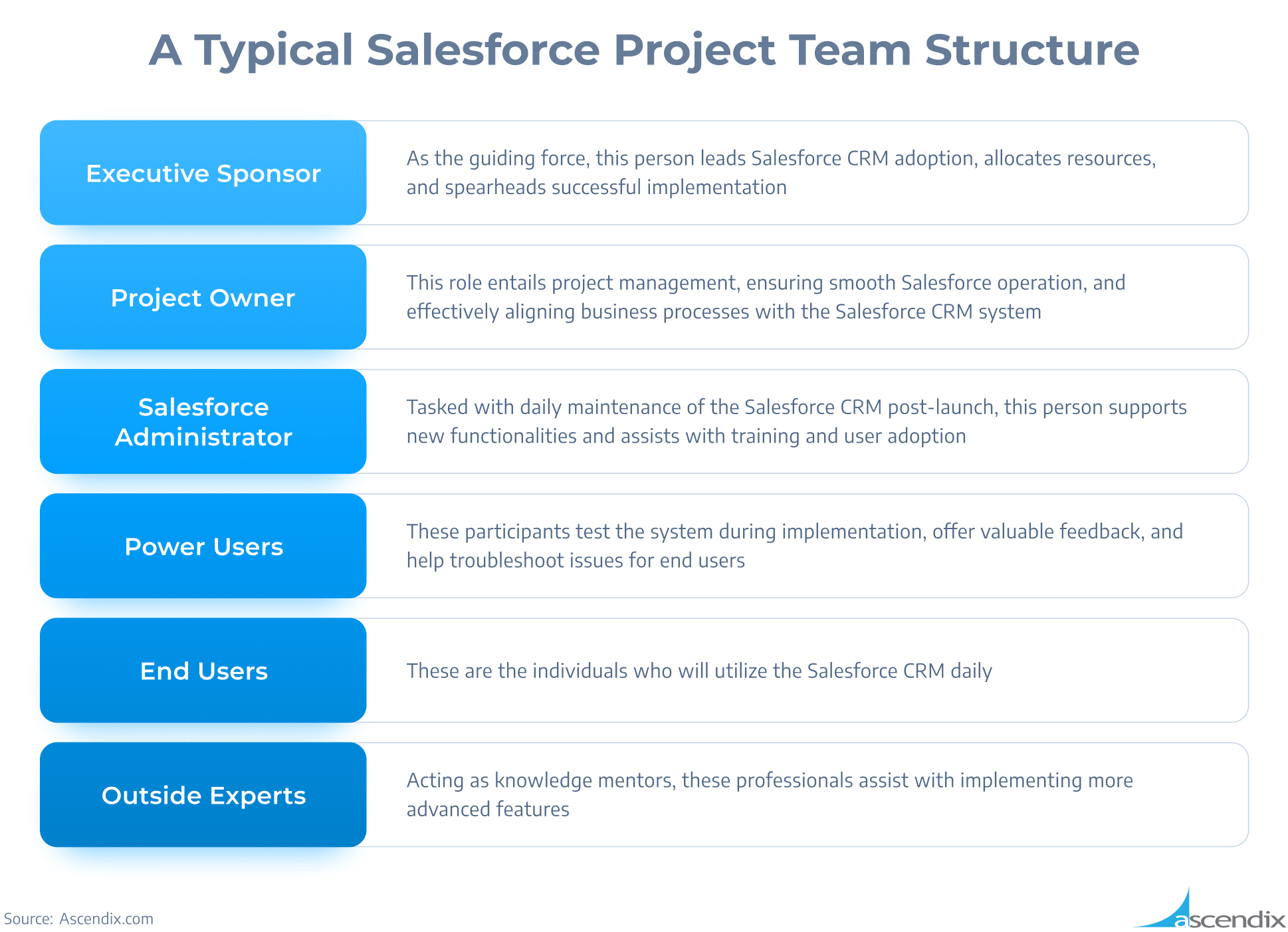
A Typical Salesforce Project Team Structure | Ascendix
A typical Salesforce project team structure and responsibilities look like this:
- Executive Sponsor – As the guiding force, this person leads Salesforce CRM adoption, allocates resources, and spearheads successful implementation.
- Project Owner – This role entails project management, ensuring smooth Salesforce operation, and effectively aligning business processes with the Salesforce CRM system.
- Salesforce Administrator – Tasked with daily maintenance of the Salesforce CRM post-launch, this person supports new functionalities and assists with training and user adoption.
- Power Users – These participants test the system during implementation, offer valuable feedback, and help troubleshoot issues for end users.
- End Users – These are the individuals who will utilize the Salesforce CRM daily.
- Outside Experts – Acting as knowledge mentors, these professionals assist with implementing more advanced features.
In addition to the roles outlined above, it’s vital to have a primary point of contact, such as a dedicated Project Manager, to oversee the project internally.
Want to Maximize your Salesforce Investment?
We will teach you how to do that right and get the most out of your Salesforce CRM.
Salesforce Implementation Project Challenges and Causes for CRM Rollout Failure
CRM projects may stumble due to a variety of factors. Common obstacles include insufficient project planning, lack of a coherent implementation strategy, and disregard for potential risks. Potential Salesforce implementation challenges include:
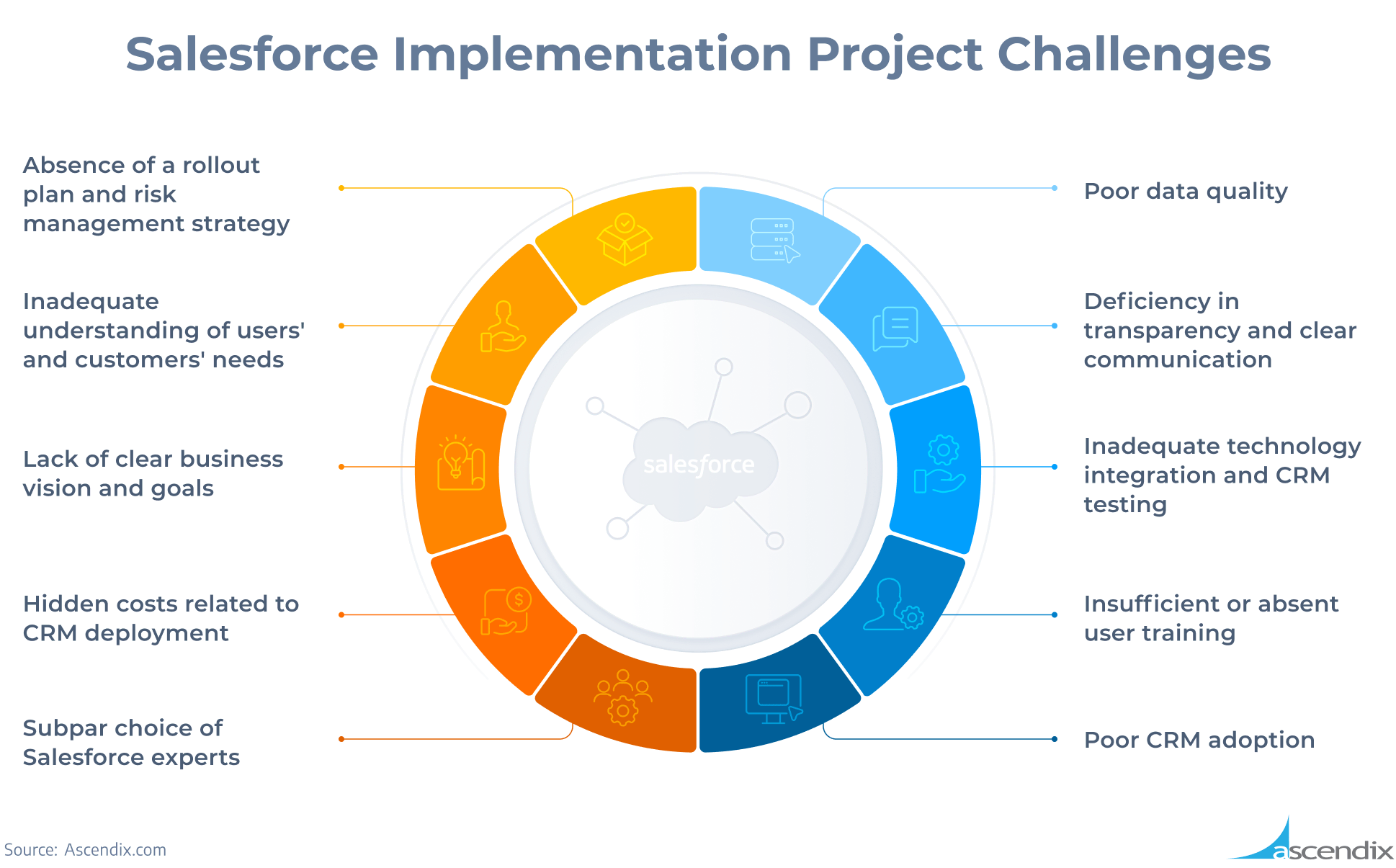
Salesforce Implementation Project Challenges | Ascendix
- Absence of a definitive implementation plan and risk management strategy,
- Inadequate understanding of users’ and customers’ needs,
- Lack of clear business vision and customer-focused goals,
- Hidden costs related to CRM deployment,
- Subpar choice of Salesforce experts,
- Poor data quality,
- Deficiency in transparency and clear communication,
- Inadequate technology integration and CRM testing,
- Insufficient or absent user training,
- Poor CRM adoption.
“ There are many reasons why Salesforce implementations fail, but here are a few to highlight:
1) Lack of management commitment of resources (allocation of internal resources and money for external consulting)
2) Lack of direct and identifiable connection between the technology and the business problem it is trying to solve
3) Lack of proper training to bring the end-user community
4) Importation of inaccurate, incomplete, or duplicate data ”
Wes Snow, the CEO/Founder at Ascendix Technologies
Navigate the Salesforce CRM Implementation Stages with Confidence
A general CRM implementation process consists of 5 phases.

Key CRM Implementation Phases | Ascendix
Stages #1: Develop a CRM Strategy
A CRM strategy is an action plan for CRM system implementation, considering users’ needs, process requirements, and technological capacities to fulfill business objectives. Key sub-stages include:
- Analyzing and documenting requirements,
- Selecting a guiding consulting partner,
- Prioritizing tasks,
- Establishing a CRM vision,
- Identifying pivotal personnel, processes, and technology needs.
Stage #2: Establish Salesforce CRM Project Foundations
In this stage, you:
- Identify project stakeholders,
- Set up governance structures,
- Determine change management requirements,
- Outline project management needs,
- Set primary success metrics,
- Develop a risk management plan.
“ Take a phased approach while you launch Salesforce implementation. Trying to accommodate too many requirements in the initial phase can unnecessarily protract the rollout, complicate the user interface and impact user adoption. Moreover, it is normal for perspectives to change as usage of the system expands which oftentimes increases the wisdom of design decisions for future implementation phases. ”
Wes Snow, the CEO & Founder at Ascendix Technologies
Stage #3: Specify Requirements & Select a SFDC Implementation Partner
In this phase, you:
- Design the process,
- Review data and identify gaps,
- Determine preliminary technology needs and explore alternative solutions,
- Draft a Request for Proposal (RFP),
- Re-evaluate technology needs.
Stage #4: Deploy a CRM System
This phase encompasses:
- Fine-tuning the CRM implementation project plan,
- Selecting the appropriate Salesforce Cloud and edition,
- Analyzing technology customization requirements,
- Developing, testing, modifying, and deploying the prototype design.
Stage #5: Train Users and Evaluate CRM Performance
This phase involves:
- Re-evaluating project documentation,
- Developing training and onboarding programs for system admins and end-users,
- Assessing success against key factors,
- Analyzing the achievement of initial business and CRM objectives,
- Organizing CRM workshops to share best practices and tips,
- Conducting follow-up training for CRM optimization,
- Reviewing the CRM project roadmap to ensure alignment with project and business goals.
“ The length of deployment is driven largely by the scope of the engagement but all things considered. If you've done an adequate job of putting a deployment roadmap in place, a viable Phase 1 Salesforce implementation should target a range from 3 to 6 months for moderately complex implementations. There are exceptions to this rule of thumb (especially for the smaller engagements of fewer than 10 users) and it should be noted that this timeframe is relating to the first of what may be a multi-phase project. ”
Wes Snow, the CEO/Founder at Ascendix Technologies
How to Create a Perfect Salesforce Implementation Project Plan in 15 Steps
Every Salesforce rollout project plan necessitates certain critical elements such as:
- Timeline
- Stakeholders
- Dependencies
- Milestones.
The timeline, typically outlined in months, should be promptly updated as each task is completed.
Stakeholders are vital to the plan, clearly identifying who is accountable for each step in the SFDC implementation.
Dependencies highlight the project’s constraints, including the necessity of executing tasks in a specific order, which must be considered during planning.
Lastly, the plan should incorporate granular milestones marking the completion of each implementation phase.
How Can You Manage a Salesforce Implementation Project?
Three principal project management methodologies can be applied to orchestrate a Salesforce CRM implementation process:
- Waterfall: This methodology is suitable for predictable projects that can be meticulously planned and executed in distinct stages. Its primary disadvantage is the difficulty of introducing changes during the testing phase.
- Agile: This approach allows for managing the implementation project in compact sequences or ‘sprints’. Agile methodology enhances flexibility, enabling swift responses to unpredictable scenarios and efficient oversight of complex projects.
- Salesforce Adaptive: This approach amalgamates the two previous methodologies for varying use cases. It ensures the comprehensive involvement of all stakeholders and optimizes project management efficiency.
How to Create a Perfect Salesforce Implementation Project Plan
To initiate successful Salesforce implementation, you need to perform a set of preliminary activities like:
- Develop a CRM strategy,
- Define project scope,
- Devise a project management plan,
- Create a communication and implementation plan.
Once all the above-mentioned actions are made, you should proceed with designing a CRM implementation project and plan. Here are the most significant project steps:
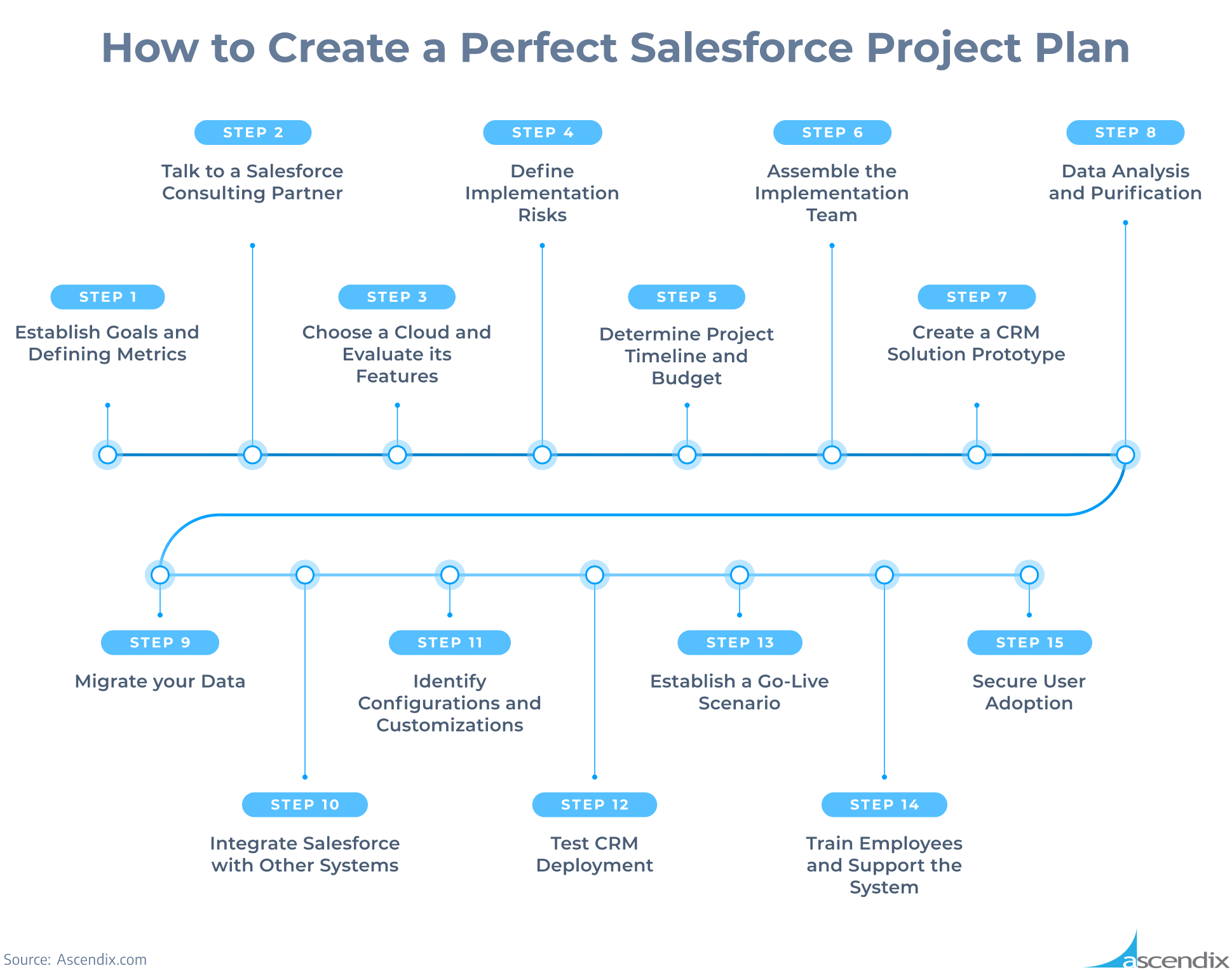
How to Create a Perfect Salesforce Project Plan | Ascendix
Step#1: Establishing Goals and Defining Metrics for Salesforce Implementation
Initiate your CRM deployment process by defining business objectives, analyzing client needs, and examining competitor and customer actions.
Convene workshops to determine detailed needs in areas such as functional, data, UI, and technical requirements.
Maintain comprehensive documentation for future reference and discussion with Salesforce implementation partners. Subsequently, set clear CRM targets, goals, and KPIs.
Step#2: Talk to a Salesforce Implementation Consulting Partner
Right after identifying all your organization’s pain points and goals, talk to a Salesforce implementation partner or consultant like Ascendix.
They provide industry-specific strategies, assisting with business case & system gap analysis, product selection, customization, optimization of Salesforce pricing, and sequencing of Salesforce Clouds and product implementation.
By leveraging their expertise, you can save considerable time and avoid potential pitfalls, especially if you lack Salesforce implementation resources or experience.
Step #3: Choose Your Salesforce Cloud and Evaluate its Features
Following your consultation with a Salesforce implementation consultant, review the available Salesforce Clouds, including their editions and functionalities.
Evaluate their compatibility with your business needs, timeline, budget, and potential for further customization.
Step #4: Define Implementation Risks
Pinpoint possible risks associated with your Salesforce implementation project and devise mitigation strategies.
At this juncture, develop a change management plan and, if necessary, restructure processes.
Step #5: Determine Project Timeline and Budget
Recognize the uniqueness of each project and its varying influences, such as company size, data volume, and required customizations. Accordingly, devise business and implementation plans, setting appropriate timelines and budgets for project completion.
Step #6: Assemble the Implementation Team
Identify decision-makers across your organization to represent all business facets, determining executive sponsorship and project leadership.
The implementation team should include sales agents, customer service representatives, IT experts, marketers, general users, and business administrators.
Step #7: Create a CRM Solution Prototype
Conduct design workshops to create functional, technical, and UI designs, ensuring thorough documentation.
Review design documentation, solicit feedback, and establish acceptance criteria. Develop a sandbox as an accurate reflection of your future production organization for testing purposes.
Step #8: Data Analysis and Purification
Poor-quality data can compromise your reputation, distort results, and potentially violate legal regulations. Prior to importing data to Salesforce, conduct an audit to assess quantity, quality, complexity, and diversity.
Identify and rectify gaps, errors, and duplicates across all objects, ensuring data cleansing, consolidation, and deduplication, and then create a CRM data model.
Consider using email verification tools, employing a data engineer for large-scale data cleansing, and utilizing data enrichment tools. Ensure clear differentiation between clients, partners, leads, and others.
“ The system is only as good as the data contained in the application. While time-intensive, an appropriate amount of time and attention to detail needs to be spent on gathering a data set that will provide valuable insight from the application during the initial stages of the deployment. To the extent possible, a CRM deployment should refrain from starting off with an empty database. ”
Wes Snow, the CEO/Founder at Ascendix Technologies
Step #9: Migrate your Data
Plan and execute data migration to Salesforce, including detailed field mapping. Facilitate a workshop to thoroughly address this.
Prioritize data protection and health in accordance with corporate policies. Automate data cleansing within the new CRM platform. Ensure data backup before migration.
Step #10: Integrate Salesforce with Third-Party Systems
Evaluate Salesforce’s compatibility with various products, taking into consideration over 3,000 dedicated apps. Identify the ideal tools that can efficiently integrate with Salesforce.
Determine if API integration is feasible or if third-party connectors or custom coding are necessary. Seek recommendations from professional Salesforce consultants to optimize investment and avoid unnecessary customization.
Step #11: Identify Necessary Configurations and Customizations
Comprehend the inherent Salesforce functionality, then identify enhancements through feature configuration or custom coding. Consider optimizing aspects such as:
- Form design,
- Fields,
- Objects,
- List views/filters,
- Reports,
- Dashboards,
- Data search,
- User security.
Also, consider modifying business processes such as:
- Workflow automation,
- Mass records updates,
- Validation rules,
- Sharing rules,
- Security permissions,
- Data tracking,
- Approval process.
This step may involve onboarding a marketing team for campaign and event setup. If tools like Marketing Cloud, Pardot, or other AppExchange marketing automation tools are purchased, coordinate additional projects with relevant consultants and your marketing team.
Step #12: Test CRM Deployment
Develop test scripts for final user acceptance testing, verifying:
- Correct data migration,
- Recognizable and fillable data fields,
- Proper association of email addresses with contacts,
- Functioning two-way email sync.
This testing approach ensures comprehensive alignment with your CRM.
Step #13: Establish a Go-Live Scenario
Allocate time for building and testing scenarios before the final Salesforce rollout. While small projects can launch simultaneously, it’s advisable to implement larger, complex projects in phases, allowing employees to acclimatize to the new system.
Step #14: Train Employees and Support System
High adoption rates hinge on proper training, ensuring continued and appropriate software use. To effectively train your team:
- Conduct group training, team sessions, and provide ongoing education.
- Offer online demos and walkthrough videos post-training.
- Advocate for participation in Salesforce Trailhead, a free education platform with numerous courses.
- Initiate knowledge-sharing sessions and workshops, reinforcing training, especially for admins overseeing CRM deployment and adoption.
Step #15: Secure User Adoption and Implement Additional Features
CRM adoption signifies stakeholders confidently utilizing the software, resulting in simplified workflows. Despite this, Salesforce implementation is ongoing, reflecting your ever-evolving business needs.
Post initial rollout, consider expanding the system or adjusting customizations.
To enhance efficiency, maintain receptivity to user feedback, regularly evaluate your CRM, and modify functionality as required.
Our 7 Fit-for-All Salesforce Cloud Implementation Best Practices
For over 20 years of Salesforce consulting, our experts have collected a set of recommendations on how to launch and drive Salesforce implementation projects well. Among them:

Our Salesforce Implementation Best Practices | Ascendix
- Tip #1: Have a balanced approach,
- Tip #2: Take a phased approach,
- Tip #3: Get feedback on all levels,
- Tip #4: Build a Salesforce implementation team of true experts,
- Tip #5: Have a realistic estimation of the project timeline and budget,
- Tip #6: Encourage data hygiene,
- Tip #7: Ensure user adoption.
The Role of a SF Consultant in Successful CRM System Implementation
Engaging a Salesforce implementation consultant optimizes the chances of successful Salesforce implementation.
If you encounter difficulties with Salesforce platform implementation, re-implementation, optimization, or require guidance transitioning from Salesforce Classic to Salesforce Lightning, our Salesforce implementation professionals are at your service.
Why Ascendix is a Reliable Partner for Salesforce Implementation Services?
Our track record of 20 years in Salesforce platform consulting, deployment, customization, and custom development, alongside positive feedback from over 200 clients, attests to our reliability.
Our industry-specific expertise ensures an understanding of your niche CRM requirements.
Our technically proficient team, certified by internationally recognized bodies, is committed to your project. Furthermore, our global delivery capability promises competitive cost structures through blended or offshore staffing models.
Ready to start with us? Book a free CRM consulting call.
SFDC Implementation Services FAQ
What is Salesforce Implementation?
Salesforce implementation involves rolling out, configuring, and developing CRM tools. It encompasses consulting, configuration, development, integration, and data migration. Key steps include design, development, testing, launch, and support. Success hinges on agile methodology, communication, planning, partner investment, and addressing challenges like user adoption, data migration, integration, costs, and security.
How to Successfully Implement Salesforce?
To successfully implement Salesforce, businesses should follow a structured approach:
- Define CRM strategy and objectives,
- Set clear timelines and resources,
- Design CRM processes,
- Plan organizational change management,
- Configure Salesforce,
- Conduct thorough testing.
- Provide user training,
- Drive user adoption,
- Continuously optimize Salesforce,
- Manage the post-implementation process.
What is the Roadmap of Salesforce Implementation?
The Salesforce implementation roadmap consists of key stages:
- Planning: Kick-off meetings, product selection, team assembly.
- Discovery: Analyze business needs, set project goals, develop PoCs.
- Design: Configure UX/UI, objects, reports, and custom development if needed.
- Integration: Connect Salesforce with other systems for data flow.
- Validation: Test and adjust to meet requirements.
- Roll-out: Deploy and migrate data with minimal disruption.
- Support: Get post-implementation assistance and ongoing maintenance to maximize system benefits.
How Long does a Salesforce Implementation Take?
Salesforce implementation duration varies based on factors like feature scope, system complexity, and customization needs. Timelines range from a few months for process automation to a year for extensive changes. Adaptability ensures alignment with each organization’s unique needs and goals.
Anzhelika Serhiienko , Content Creator & Marketer at Ascendix
Anzhelika is a seasoned B2B content marketing strategist with extensive experience in elevating corporate profiles through compelling content. At Ascendix, she offers a wealth of knowledge in Salesforce consulting, providing valuable tips, tricks, and comprehensive guides. Additionally, Anzhelika stays at the forefront of the industry, delivering expert analysis on the latest Salesforce tools and emerging technology trends.








Thanks, I enjoyed reading this blog. It was informational content. It might be helpful in case you are looking for Salesforce implementation services